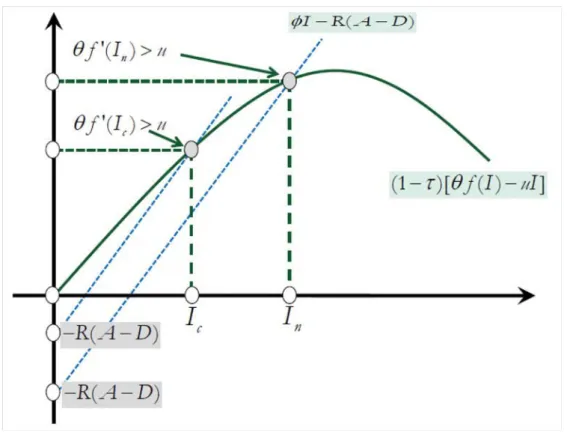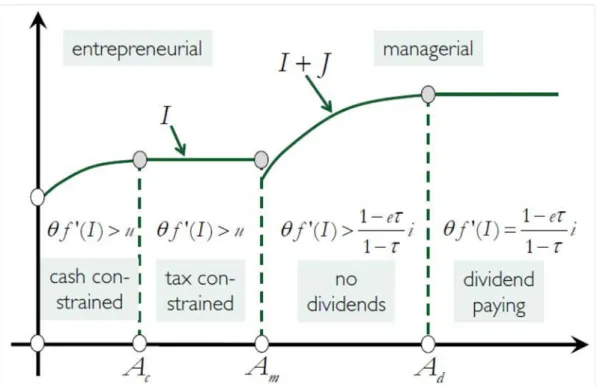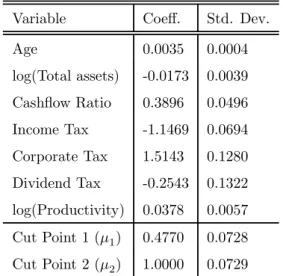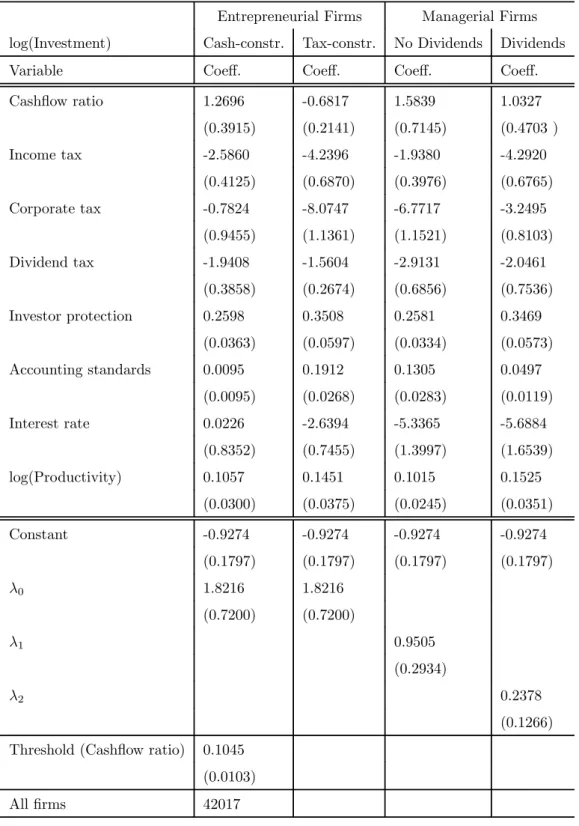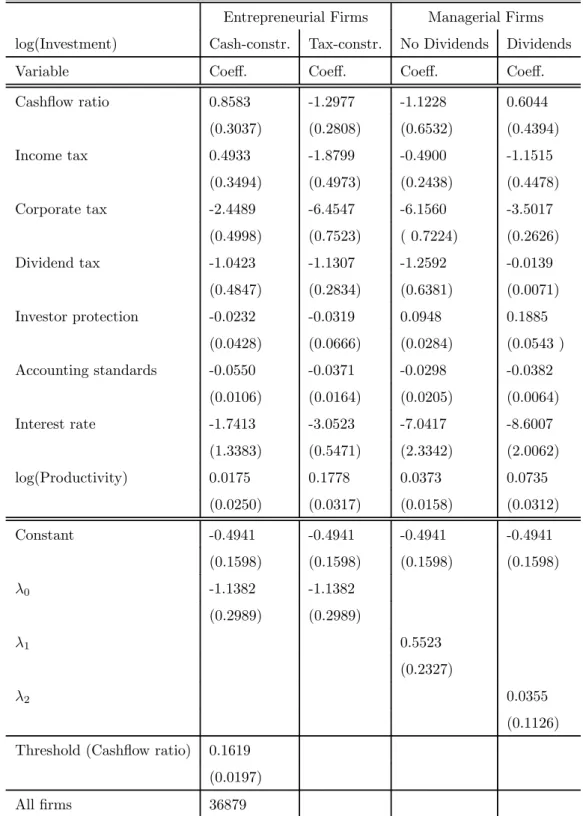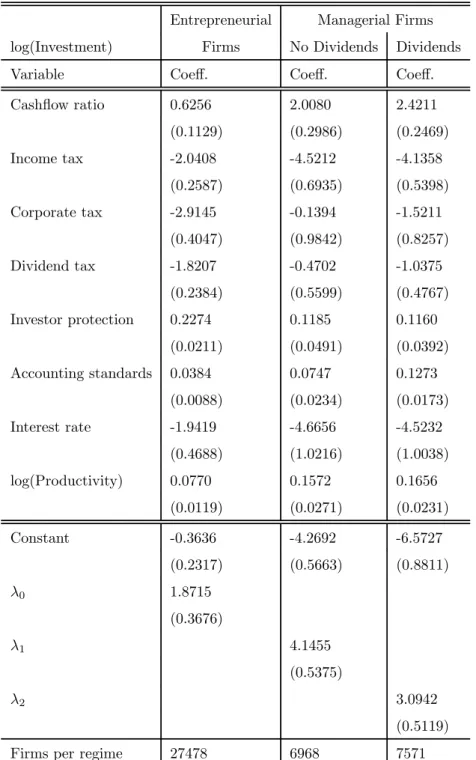IHS Economics Series Working Paper 306
September 2014
Heterogeneous Tax Sensitivity of Firm-level Investments
Peter Egger Katharina Erhardt Christian Keuschnigg
Impressum Author(s):
Peter Egger, Katharina Erhardt, Christian Keuschnigg Title:
Heterogeneous Tax Sensitivity of Firm-level Investments ISSN: Unspecified
2014 Institut für Höhere Studien - Institute for Advanced Studies (IHS) Josefstädter Straße 39, A-1080 Wien
E-Mail: o ce@ihs.ac.atffi Web: ww w .ihs.ac. a t
All IHS Working Papers are available online: http://irihs. ihs. ac.at/view/ihs_series/
This paper is available for download without charge at:
https://irihs.ihs.ac.at/id/eprint/2908/
Heterogeneous Tax Sensitivity of Firm-level Investments
Peter Egger1, Katharina Erhardt1 and Christian Keuschnigg2
1ETH Zuerich
2Institute for Advanced Studies, Vienna and University of St. Gallen
September 2014
All IHS Working Papers in Economics are available online:
https://www.ihs.ac.at/library/publications/ihs-series/
Economics Series
Working Paper No. 306
Heterogeneous Tax Sensitivity of Firm-level Investments
∗Peter Egger, Katharina Erhardt & Christian Keuschnigg July 31, 2014
Abstract
Firms are heterogeneous in size, productivity, ownership concentration, gover- nance, financial structure and other dimensions. This paper introduces a stylized theoretical framework to account for such differences and to explain the heteroge- neous tax sensitivity offirm-level investments acrossfirm types. We econometrically test the theoretical predictions, taking account of selection of firms into different regimes. Wefind important differences in the tax sensitivity of investment of small entrepreneurial and larger managerial firms in different financial regimes that are largely in line with theoretical results.
JEL classification: D22, G32, H25, L21.
Keywords: Corporate tax; Personal taxes; Firm heterogeneity; Access to capital;
Manager-shareholder conflicts.
Egger: ETH Zuerich, KOF, Leonhardstrasse 35, CH-8092 Zuerich. Co-affiliations:
CEPR, CESifo, and Oxford Centre of Business Taxation.
Erhardt: ETH Zuerich, KOF, Leonhardstrasse 35, CH-8092 Zuerich.
Keuschnigg: Institute for Advanced Studies, Vienna, and University of St. Gallen (FGN-HSG), Varnbuelstrasse 19, CH-9000 St. Gallen.
∗Keuschnigg appreciatesfinancial support from the Swiss National Science Foundation (project no.
100018_146685). We are grateful for comments by participants of the Tuebingen 2014 Workshop on Tax Policy and the Activities of Multinational Firms, the Transatlantic Public Economics Seminar 2014 in Vienna and, in particular, by our discussants Dominika Langenmayr and Harry Huizinga.
1 Introduction
Firms differ along several important dimensions: by age and own funds (young and ma- ture), R&D intensity (innovative and less innovative), ownership structure (concentrated and dispersed), types of governance, and other characteristics. These characteristics are related to specific agency problems and financial regimes.
Young, innovative firms tend to be entrepreneur-centered with concentrated owner- ship, have large growth potential but little own funds and are, thus, often financially constrained. Financial constraints arise from moral hazard, limiting the amount of earn- ings that can be pledged for repayment of external funds. Lacking the possibility of internal funding (due to limited own funds and current profits), young and innovative
firms heavily rely on external funding and do not pay dividends. Afirm’s debt capacity,
and thereby the tightness of financial constraints on external financing, depends onfirm- specific factors (e.g., the availability of own funding and of collateral), country-specific institutional factors (e.g., accounting standards, bankruptcy regulations, financial sector efficiency) and on country-specific tax factors (e.g., the personal income-tax level and progressivity, and profit-tax rates). Financially constrained firms earn an excess return on capital and tend not to respond to user-costs of capital. Taxes affect investment not via the user-costs of capital, but rather by their effect on pledgeable earnings.
Medium-sized companies with still relatively concentrated ownership have more own funds and larger earnings, and have less problems in raising credit. The user-costs of capital, reflecting both personal income (dividend) and profit taxes, should become a more important determinant of investment for suchfirms relative to smaller ones.
At some point, the entrepreneur will wish to sell out to diversify her wealth, and the firm may become public. For that reason, largefirms are less dependent on external credit.
Investment tends to be financed by retained earnings at the margin. Shareholders install an independent management and form a board to supervise the firm. The self-interest and independence of managers leads to a preference for retained earnings over dividend
payouts and to partly inefficient investment associated with perks and other benefits in the interest of management. If funds are relatively scarce,firms refrain from paying dividends to maximize retained earnings which are partly diverted to inefficient projects serving the interest of management. Investment depends on dividend and corporate taxes and is also driven by institutional and corporate governance variables such as board composition, voting rights and investor protection.
If even more internal funds are available, firms pay dividends. In large, dividend- payingfirms, investment depends on the user-costs of capital, while dividend payouts are driven by institutional and corporate-governance variables.
Empirical research on the tax determinants of investment falls in three groups. First, a large traditional literature does not specifically take account of financial frictions and problems of corporate governance and investigates mainly how investment depends on the user-costs of capital. Hassett and Hubbard (2002) review the empirical literature and report estimates of investment elasticities with respect to the user-costs in the range between -0.5 and -1.0. Auerbach and Hassett (2003) show how the effects of dividend and corporate taxes depend on the marginal source of funds.1 In contrast, when firms
are finance-constrained, investment becomes sensitive to cash-flow, own collateral and
institutional country characteristics (see Hubbard, 1998, for an early survey).
A second strand of the empirical literature emphasizes the prevalence of credit con- straints. In general, young and small firms are more likely to be credit-constrained than large firms (Beck et al., 2005; Aghion et al., 2007). Both entry and subsequent firm growth are limited by financial frictions (see Hubbard, 1998; Beck and Demirguc-Kunt, 2006; Aghion et al., 2007). Empirical research also finds that innovative firms tend to face tighter financing restrictions than non-innovative firms (Himmelberg and Petersen, 1994; Guiso, 1998; Hall and Lerner, 2010). Chirinko and Schaller (1995) and Hoshi et al.
(1991) report elasticities of physical capital investment to cash-flow of around 0.4-0.5. Es-
1See Auerbach (2002) for a review of corporatefinancial policy and investment and Gordon and Dietz (2008) for tax explanations of dividend policies.
timates for total working capital are significantly higher and vary between 0.8 to 1.3 (see Fazzari and Petersen, 1993; Calomiris and Hubbard, 1995; and Carpenter and Petersen, 2002). Ellul et al. (2012, 2010) find taxes to have a significant impact on investment and to importantly interact with institutional or firm specific characteristics that relate to credit constraints. Finally, a third strand of the literature discusses taxes and other determinants of investment and dividend-payout behavior in largefirms with a manager- shareholder conflict. Chetty and Saez (2005, 2006, 2010) theoretically and empirically consider the effects of dividend and corporate taxes on investment and dividend behavior.
Desai et al. (2007) show that corporate taxes interact with investment and rent diversion by managers.
This paper will outline a theoretical model that features relatively small entrepre- neurial firms that are financially constrained, and large firms with dispersed ownership and manager-shareholder tension. Depending on the level of own funds, R&D intensity and ownership structure, firms respond in different ways to personal and corporate in- come taxes and are affected by different types of institutional variables. These different characteristics lead to a heterogeneity of tax elasticities which could not be explained by taxation in a first-best world.
The paper will shed light on the heterogeneity of investment responses across firm types to effective (personal, corporate, and dividend) income taxation empirically. We make use of accounting information from a large data-set on individual firms. This data- set provides information on the profits, sales, financial assets, intangible assets (as a measure of R&D intensity), and owner structure of thousands offirms in a set of European countries. In conjunction with detailed information on those countries, we are able to determine the hypotheticalfirst-best user-costs of capital perfirm. Moreover, we will be able to assess to which extent the user-costs of capital matter more or less depending on thefinancial constraints firms face. The empirical approach unifies two features: (i) a flexible impact of taxes and costs of capital onfirm-level investment, and (ii) the potential endogeneity of effective taxes due to the choice of the firm type (entrepreneurial versus
managerial firms, and dividend payments or not, etc.). One merit of this approach is to determine empirically the susceptibility of investments acrossfirms in terms of observable characteristics with special emphasis on the personal and corporate tax system.
The empirical analysis largely confirms theoretical predictions. In small entrepreneur- ial firms that are subject to credit rationing, investment depends positively and signif- icantly on own cash-flow and on investor protection restraining the potential diversion of funds by entrepreneurs. For instance, a marginal increase of the cashflow ratio of cash-constrained firms raises investment of those firms by about 1.3 percent. A marginal increase in investor protection raises investment by suchfirms by about 0.3 percent. These variables lose power whenfirms are endowed with more own funds. Taxes negatively affect investment. With a semi-elasticity of about -2.6, the personal income tax is most rele- vant for small, cash-constrained entrepreneurial firms, while larger entrepreneurial firms are most negatively affected by the corporate tax (at a semi-elasticity of about -8.1).
With non-dividend-paying managerial firms, investment is most negatively affected by the corporate tax (at a semi-elasticity of about -6.8) which becomes less important once firms start paying dividends (at a semi-elasticity of about -3.2). Dividend taxes mainly affect the extensive margin of investment. Institutional characteristics such as investor protection and accounting standards are important determinants of investment as well.
The paper is organized as follows. Section 2 sets out a theoretical model to explain the heterogeneous tax sensitivity of investment in response to personal and corporate income taxes. Section 3 describes the data-set and introduces the econometric methodology.
Section 4 presents the main empirical findings, Section 5 reports on robustness checks, and Section 6 concludes.
2 The Model
Entrepreneurial firms are run by managing owners and may be financially constrained or unconstrained. Financial constraints root in the tension between the entrepreneur
and external investors and could lead to underinvestment coupled with an excess return on capital. In contrast, large managerial firms are run by a professional manager and owned by external equity investors. So there is a manager-shareholder conflict, potentially leading to overinvestment and below-normal returns on investment.
Entrepreneurial firms do not have an independent board that represents shareholder interests and, therefore, do not have access to external equity but are rather dependent on bank credit. External equity financing is associated with the entrepreneur ‘going public’
to raise funds on the stock market or selling out a substantial share to other investors.2 For predictions regarding a cross section offirms, we may assume that entrepreneurs have a higher discount rate than investor-ownedfirms (see Michelacci and Suarez, 2004), , so that managerial firms have larger firm value, all else equal. On the other hand, selling out to investors requires setting up a board and hire a manager which reduces the value to owners. Given this trade-off, smallerfirms with limited own funds remain entrepreneurial and larger ones choose a managerial structure with diversified ownership.
2.1 Entrepreneurial Firms
We introduce a simple model of a manager-owned entrepreneurial firm. Investment is possibly credit-rationed, yielding an unexploited excess-return on capital. Thefirm invests
to generate net earnings(), where0 0 00. Investment isfinanced by own funds
and external debt . Dividends in periods zero and one are and 1, and corporate tax liabilities are and 1, respectively. Capital must earn a rate of return or interest equal to. By subtracting opportunity costs of own funds(1 +), we definefirm value as a surplus over own funds. Financial identities are
=+ −−· 1 =() +−(1 +) (+)−·1 (1) where tax bases are ≡ − and1 ≡() +−. For simplicity, we do not model any current taxable earnings in period 0 so that is negative. In period 1, we need to
2We do not equate ‘going public’ with stock-market listing. Many medium sizedfirms remain unlisted but have several owners, establish a board of directors and hire a professional manager.
take account of disinvestment, leading to an extra tax . Dividends thus amount to
=+ −(1−) and
1 = (1−)() + (1−)−(1 + (1−))−(1 +) (2) Beginning-of-periodfirm value (surplus) is the present value of dividends net of own funds,
= max
(1−)+(1−)1
1 + (2) (3)
or = (1−) [(1−) (()−(1−)) + (−)](1 +).
First-Best: Using =−+ (1−) in 1, optimality conditions are
= (1−) (1−) [0()−(1−)]
1 + = 0
= 1−
1 + · 0 (4) The firm invests until the marginal return is equal to the user-costs of capital,3
0() = (1−)· ≡ (5) Raising dividends today reduces dividends tomorrow. In the absence of tax, the effect on netfirm value is zero. If thefirm pays more dividends, it must raise more external debt.
Since interest on debt is deductible, repayment is tax-subsidized tomorrow, leaving a net gain to the firm by shifting investmentfinancing from retained earnings to external debt, (1−) = (−) +. Thefirm raises dividends as much as possible by raising more external debt which is limited to ≤(1−), or≤.
Financing Constraint: We follow Ellul et al. (2010, 2012) for a simple way of modeling credit constraints. In period 1, investment andfinancing (,, and) are pre- determined. Suppose insiders can divert earnings0. Depending on the legal environment (investor protection, antidirector laws etc.), diversion is limited to 0 ∈ [0 ]. If the entrepreneur is honest, she can promise external investors at most a repayment of +
− 1 ≥(1 +). If the entrepreneur diverts funds, she reduces pledgeable earnings by
3If interest on debt were not deductible,1=() +, the user-costs would be=11−− ·so that
for any 1. Here, deductibility of interest on debt combined with deduction of investment costs subsidizes the user-costs, , as often happens in reality for 100% debt financing (at the margin).
0 and can get external funds to the extent that reported profits remain positive, 1 =
+− 1−0−(1 +) ≥0. Given a small cost of diversion, she will never benefit from diverting minor amounts, since her total income1+0 =+− 1−(1 +) (prior to getting a return on equity) would not be affected by it.
If earnings are low and the firm is loaded with too much external funds, there might be a situation of + − 1 −(1 +) 0 + − 1 − −(1 +) = 1. Since small amounts of diversion do not add to final wealth, the entrepreneur is clearly better off by diverting the maximum amount , reporting negative book earnings, and declaring bankruptcy. Given limited liability, the entrepreneur is left with zero residual profit but keeps diverted earnings . In this case, external investors recover only part of the promised repayment, + − 1 − (1 +). To prevent this scenario, they stop lending as soon as the no-diversion constraint becomes binding, (1−) () + (1−) −(1 + (1−)) ≥ . When access to external funds is limited, the firm is forced to cut dividends and keep retained earnings to economize on external funds,
= (1−) −(−). We also assume that the entrepreneur needs at least an amount ¯ of current, after tax dividends for private needs. Using ≡1 + (1−), this leaves the no-diversion constraint to be
(1−) [()−(1−)]≥ −(−) (1−)≥¯ (6) We assume that access to external debt requires a minimum amount of self-financing:
Assumption 1 With unconstrained investment, 0(∗) = (1−), the financing con- straint is violated when retained earnings are zero, (1−) [(∗)−(1−)∗] ∗.
Entrepreneurialfirms may be in two regimes, see Appendix A for an analytical solution.
Cash-poorfirms are severely constrained and must cut dividends. Thefinancing constraint in (6) binds even if the firm pledges a maximum of own funds by reducing dividends to
= ¯(1−). Investment is implicitly determined by (6) and depends on inside equity or the legal environment as measured by , and on determinants of pledgeable earnings,
including tax payments,4
=
·− 1−
·+(1−)
·−
· (7)
: −(1−)
·+(1−)
·− 1+
· where ≡−(1−) (0−)0 and ≡1 + (1−).
Figure 1 illustrates how thefinancing constraint in (6) determines investment. Invest- ment rises with own funds and declines with higher cost of capital, with deteriorating institutional quality (higher ), and with a higher dividend tax. Cash-poor firms with little own funds are heavily constrained and cut dividends to preserve retained earnings for self-financing,= ¯(1−). A higher dividend tax thus requires larger gross div- idends, thereby limiting retained earnings and reducing investment. Being constrained, firms are left with unexploited investments and earn an excess-return.
Insert Figure 1 About Here
If a firm is endowed with relatively high own funds, it starts to pay larger dividends.
It could invest at thefirst-best level, pay out dividends, and raise external debt such that thefinancing constraint ‘just binds’, see thefirst inequality in (6). At that point, pushing for higher dividends would reduce retained earnings even further and restrict investment.
Given the tax-advantage of debt, this strategy is value-increasing, since a small cut in investment does not affect firm value, while a small increase in debt-financed dividends is strictly value-increasing due to tax savings, see (4). Therefore, optimal investment is reduced below thefirst-best level and still earns an excess-return:
0()−(1−)= 1−
1 + 0;
see the discussion of (A.3) and the illustration in Figure 1. Since thefinancing constraint becomes binding only for tax reasons, while the firm would be unconstrained in the
4Write[−(1−)−(1−)+]· = (1+)· by using the definition of tax bases and= (1−)−+.
absence of tax, we call this regime tax-constrained as opposed to the cash-constrained one. Investment of a tax-constrained entrepreneurial firm changes by
= − (1−) (1 +)
1
−00 ·−
∙
1− + (1−) (1 +)2
¸ 1
−00 · (8) : + 0
−00 ·−
∙ 1 (1−)2
1 + −
¸
−00 · +
−00 ·
Results are as expected. A constant dividend tax rate has no impact any more, since it does not constrain the firm’s choice between present and future dividends. A higher corporate tax rate reduces investment, because it makes firms to pay out even more dividends today to exploit the larger tax-advantage of debt, accepting a somewhat smaller level of investment due to diminishing internal funds. A slight ambiguity remains, since a larger tax rate magnifies the value of the investment tax credit which in itself strengthens cash-flow and investment. This effect is unimportant, if the tax credit is small (→0).
Insert Figure 2 About Here
Firm Value: Firms differ in own funds . Given low own funds, the financing- constraint binds, even if retained earnings are maximized by cutting dividends to =
¯ (1−), implying external debt equal to = (1−)−+. Investment follows from (6) and depends on. Noting (2),firm value rises with own funds, at least for small taxes ( →0),
= (1−)(1−) (0−) −
1 +
= 0 (9)
When own funds are larger, investment istax-constrained and is independent of, see (8). Given interest deductibility of debt, thefirm wants to raise as much external debt as possible. Given, thefinancing constraint yields the minimum level of retained earnings,
(−) =−(1−) (()−), and thereby the maximum level of external debt,
= (1−) −(−). Hence, both investment and external debt, and , are independent of so that current dividends=+−(1−) rise one to one with own funds, while dividends in the subsequent period decline in proportion to 1 +. The net discounted effect is zero. Thefirm’s surplus is not affected by larger own funds.
Clearly, a cash-poorfirm iscash-constrained so that more own funds boost investment and add tofirm value in proportion to the excess return. The effect eventually disappears when investment and dividend pay-out are exclusively driven by the tax-advantage of debt. Figure 2 illustrates this relationship. There is a cut-off value such that firms with are cash-constrained and do not pay dividends, while firms with more own funds are constrained only for tax reasons and pay dividends. Figures 2 and 3 compare entrepreneurial and managerialfirms and display howfirm values and investment change with own funds.
Insert Figure 3 About Here
2.2 Managerial Firms
We assume that entrepreneurial firms have no access to external equity. Their marginal source offinance is debt. Once the entrepreneur has largely exhausted excess-returns (the
firm is cash-rich), she wants to sell out by going public. The firm becomes managerial,
subject to a new agency problem. Since enough own funds are available, the marginal source of finance is retained earnings, as in the new view on dividend taxation. We thus exclude further investment-financing with new equity in addition to the acquisition of
. Such firms do not pay dividends, not because of a shortage of own funds but rather because of managers’ overinvestment in perks and pet projects.
2.2.1 Agency Model
In largefirms (high), entrepreneurs divest and sell out to external investors who require a lower return on their diversified portfolio, , but are passive owners and must hire a manager (possibly the founding entrepreneur). It is now the manager who can divert a part of the firm’s funds, instead of productively investing it. In total, she spends
+ where does not add to the firm’s earnings (). After spending on investment, managers use the remaining funds to pay out dividends. Abstracting from new equity
issues, the marginal source of finance is retained earnings, leading to the initial-period financial identity(1−) (+) =−. In the subsequent period,
1 = (1−)() + (1−) (+)−(1 +) (10) Defining firm value as a surplus net of opportunity costs, we must subtract (1 +) before dividends are shared with managers and other stakeholders. Using financial iden- tities, the present value of dividends is = (1−) [+1(1 +)], or
= (1−)
∙
+(1−)() +−−(1 +) 1 +
¸
(11)
which yields = (1−) [(1−) ()−(1−)(+)](1 +).
Managers decide on investment and dividend policy. Part of total investment spend- ing does not add to earnings but yields private benefits () to the manager. Active shareholders sit on the board, provide oversight, and control and set executive compen- sation (at dividend-share) to realign manager and shareholder interests. Firm value is divided among managers and shareholders (superscripts and),5
=· + ()
(1 +) − = (1−)· + ∗ = + ()
(1 +) (12) Active owners (board members) acquire thefirm and cede a shareto managers, possibly against a payment . The board thus keeps a residual share of 1−. Private benefits from less productive investment are reduced by tighter monitoring by board members and higher institutional quality relating to investor protection, antidirector rights, ac- counting standards, etc. Given that our focus is on investment decisions, we refrain from endogenizing board monitoring. In our simplified framework, parameter thus captures the effects of monitoring and institutional quality.
5We also introduce∗=+.
2.2.2 First Best
Suppose shareholders can observe private benefits (institutional quality → ∞). Maxi- mizing the joint surplus∗ thus yields
∗
= 1−
1 + (1−)
∙
0()− 1−
1−
¸
= 0 (13)
∗
= −1−
1 + (1−)0() + 0() (1 +) ≤0
The first condition yields and the second implies . As long as 0(0) is finite, → ∞ implies →0and residual dividends=−(1−). In thefirst-best scenario, there is no diversion of funds. Investment exclusively depends on the user-costs of capital.
If managers are not wealth-constrained, thefirst-best solution can be implemented by selling thefirm to them (set= 1) at a price that extracts their surplus, =+(1+)() , giving a value = to board members. Managers maximize + (1+)() and choose investments as in (13), leading to = 0for→ ∞as before. Since all surplus is extracted from managers by the price , board members get the entire surplus equal to
= = (1−)(1−) ()−(1−)
1 + (14)
Comparing (3) and (14), a managerial firm — in the absence of tax — is larger and has greater value in the first-best scenario than an entrepreneurial firm, since implies
. They would be exactly equal if = . With taxes, there is a countervailing effect. Entrepreneurial firms are favored, since interest on external debt is deductible, while opportunity costs of equity (internal finance) are not.
2.2.3 Investment and Dividend Policy
To discourage unproductive investments that are directed towards private benefits, man- agers are offered a share to boost incentives for value maximization. We assume that managers are wealth-constrained, = 0, leaving them with rents at the ex- pense of board members. Total rent consists of monetary income and private benefits,
= +(1+)() , where is stated in (11). Given a contract, the manager maximizes rent by setting investment and dividends subject to = (−)(1−)−,
= max
·(1−)
∙
+ (1−)() +−−(1 +) 1 +
¸
+ ()
(1 +) (15) The trade-offis in paying out funds to investors or retaining for investment and managerial perks.6 Optimality requires
= (1−)(1−)0()−0()
1 + = 0 (16)
= (1−)(1−)−0()
(1−) (1 +) ≤0 (17)
Depending on the sign of the second condition, one must distinguish two cases.
No Dividend, = 0: If paying dividends reduces the manager’s rent, 0, she sets= 0. Investment follows from
(1−) (1−)·0() =0() =
1− − (18) This condition implicitly determines productive investment and, in turn, yields. In- vestment no longer depends on user-costs but rises with internal funds , higher man- agerial profit share , better governance or higher institutional quality (larger ). Using
∇ ≡ −(1−) (1−)00−00 0, we have7
= −00
(1−)∇ ·+ 0
∇ ·+ 0
∇·+ 0
2∇· (19)
: −(1−)0
∇ ·− (1−)0
∇ ·+ −00
∇
+
1− (· +·) A larger profit share and better governance or a better institutional environment lead managers to focus more on value-maximization and productive investment. Taxes or
firm-level productivity reduce firm value relative to the value of private benefits and
6Given diversified ownership, none of the shareholders has committed a dominant share of their portfolio to a singlefirm. In constrast to (6), we thus ignore the need for minimum dividends.
7Using the f.o.c., we can also write = 00000+0000 1
1− 1−1.
thereby induce managers to shift resources from productive investments to unproductive ones.
Unproductive investment changes by =1− − and total spending by
(+) = 1
1− ·+
(1−)2 (· + ·)
Dividend Payout, 0: If thefirm pays dividends, investment is given by () :0() = 1−
1− () : (1−) (1−)= 0()
(20)
The manager productively invests as in (i) and diverts as in (ii) which, in turn, yields residual dividends = −(1−) (+). Cash-rich firms choose productive investment to maximize firm value so that the return on investment is equal to the user- costs of capital. In particular, productive investment is independent of own funds .
The manager-shareholder conflict merely concerns the use of excess funds for dividend payments to investors vs. diversion of funds to perks and managerial benefits. We have
= 0
−00 ·− 0
−00 ·+ 1−
−00 ·− 1− (1−)2
−00 · (21)
= − 0
−00− 0
−00
∙
+
¸ + 0
−00
1−
+ 0
−00 µ
1− +
1−
¶
( +) = 0
−00−
∙ 0
−00 + 0
−00
¸
− 0
−00
∙
+
¸
: + 0
−00
1−
+
∙ 0
−00 + 0
−00
¸
1− −
µ1− 1−
0
−00 − 0
−00
¶
1− Dividends=−(1−) (+) are residual and change by
= −(1−) 0
−00 ·+ (1−) 0
−00 ·
∙
+
¸
: + (1−)
∙ 0
−00 + 0
−00
¸
·−(1−) 0
−00 ·
1−
(22) : +
∙
(+)+ 1− 1−
0
−00 − 0
−00
¸
· +
∙
+− 0
−00 − 0
−00
¸
·
Table 1 summarizes the empirical predictions of how various shocks affect the intensive margin of investment.



